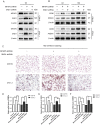Microfibrillar-associated protein 5 suppresses adipogenesis by inhibiting essential coactivator of PPARγ
- PMID: 37020143
- PMCID: PMC10076305
- DOI: 10.1038/s41598-023-32868-y
Microfibrillar-associated protein 5 suppresses adipogenesis by inhibiting essential coactivator of PPARγ
Abstract
Femoral head necrosis is responsible for severe pain and its incidence is increasing. Abnormal adipogenic differentiation and fat cell hypertrophy of bone marrow mesenchymal stem cells increase intramedullary cavity pressure, leading to osteonecrosis. By analyzing gene expression before and after adipogenic differentiation, we found that Microfibril-Associated Protein 5 (MFAP5) is significantly down-regulated in adipogenesis whilst the mechanism of MFAP5 in regulating the differentiation of bone marrow mesenchymal stem cells is unknown. The purpose of this study was to clarify the role of MAFP5 in adipogenesis and therefore provide a theoretical basis for future therapeutic options of osteonecrosis. By knockdown or overexpression of MFAP5 in C3H10 and 3T3-L1 cells, we found that MFAP5 was significantly down-regulated as a key regulator of adipogenic differentiation, and identified the underlying downstream molecular mechanism. MFAP5 directly bound to and inhibited the expression of Staphylococcal Nuclease And Tudor Domain Containing 1, an essential coactivator of PPARγ, exerting an important regulatory role in adipogenesis.
© 2023. The Author(s).
Conflict of interest statement
The authors declare no competing interests.
Figures





Similar articles
-
Glucocorticoid Enhanced the Expression of Ski in Osteonecrosis of Femoral Head: The Effect on Adipogenesis of Rabbit BMSCs.Calcif Tissue Int. 2019 Nov;105(5):506-517. doi: 10.1007/s00223-019-00592-3. Epub 2019 Jul 30. Calcif Tissue Int. 2019. PMID: 31359074
-
C/EBPα regulates the fate of bone marrow mesenchymal stem cells and steroid-induced avascular necrosis of the femoral head by targeting the PPARγ signalling pathway.Stem Cell Res Ther. 2022 Jul 26;13(1):342. doi: 10.1186/s13287-022-03027-3. Stem Cell Res Ther. 2022. PMID: 35883192 Free PMC article.
-
Microfibrillar-associated protein 5 regulates osteogenic differentiation by modulating the Wnt/β-catenin and AMPK signaling pathways.Mol Med. 2021 Dec 5;27(1):153. doi: 10.1186/s10020-021-00413-0. Mol Med. 2021. PMID: 34865619 Free PMC article.
-
miR-27a attenuates adipogenesis and promotes osteogenesis in steroid-induced rat BMSCs by targeting PPARγ and GREM1.Sci Rep. 2016 Dec 2;6:38491. doi: 10.1038/srep38491. Sci Rep. 2016. PMID: 27910957 Free PMC article.
-
PPARγ and Wnt Signaling in Adipogenic and Osteogenic Differentiation of Mesenchymal Stem Cells.Curr Stem Cell Res Ther. 2016;11(3):216-25. doi: 10.2174/1574888x10666150519093429. Curr Stem Cell Res Ther. 2016. PMID: 25986621 Review.
Cited by
-
Identifying differentiation markers between dermal fibroblasts and adipose-derived mesenchymal stromal cells (AD-MSCs) in human visceral and subcutaneous tissues using single-cell transcriptomics.Stem Cell Res Ther. 2025 Feb 11;16(1):64. doi: 10.1186/s13287-025-04185-w. Stem Cell Res Ther. 2025. PMID: 39934849 Free PMC article.
-
Embryonic thermal conditioning and post-hatch heat challenge alter hypothalamic expression of genes related to appetite, thermoregulation, and stress modulation in broiler chicks.Front Physiol. 2025 Jun 17;16:1583958. doi: 10.3389/fphys.2025.1583958. eCollection 2025. Front Physiol. 2025. PMID: 40600125 Free PMC article.
-
CTHRC1 Expression Results in Secretion-Mediated, SOX9-Dependent Suppression of Adipogenesis: Implications for the Regulatory Role of Newly Identified CTHRC1+/PDGFR-Alpha+ Stromal Cells of Adipose.Int J Mol Sci. 2025 Feb 20;26(5):1804. doi: 10.3390/ijms26051804. Int J Mol Sci. 2025. PMID: 40076432 Free PMC article.
-
Recent advances in osteonecrosis of the femoral head: a focus on mesenchymal stem cells and adipocytes.J Transl Med. 2025 May 27;23(1):592. doi: 10.1186/s12967-025-06564-6. J Transl Med. 2025. PMID: 40426076 Free PMC article. Review.
References
-
- Tan G, Kang P-D, Pei F-X. Glucocorticoids affect the metabolism of bone marrow stromal cells and lead to osteonecrosis of the femoral head: A review. China Med. J. 2012;125:134–139. - PubMed
Publication types
MeSH terms
Substances
LinkOut - more resources
Full Text Sources
Medical

